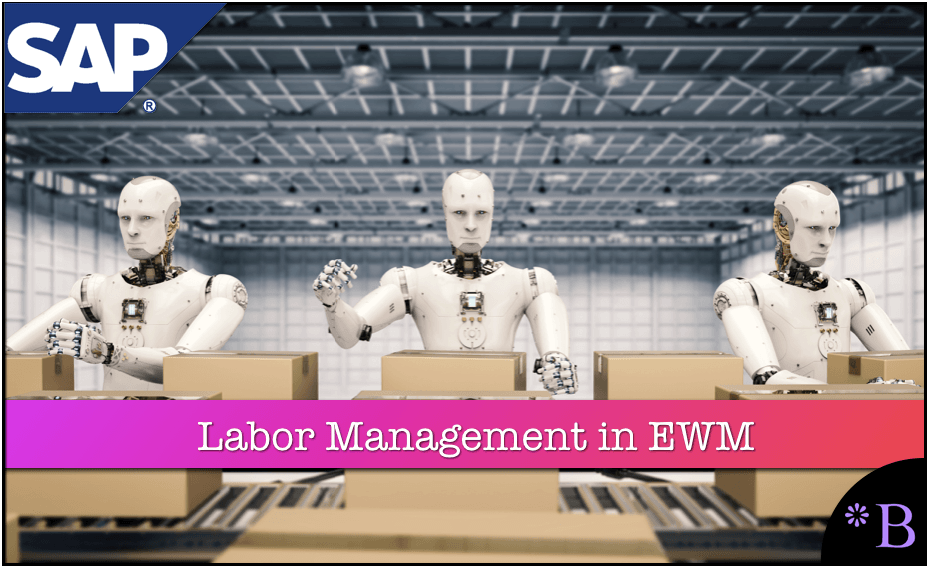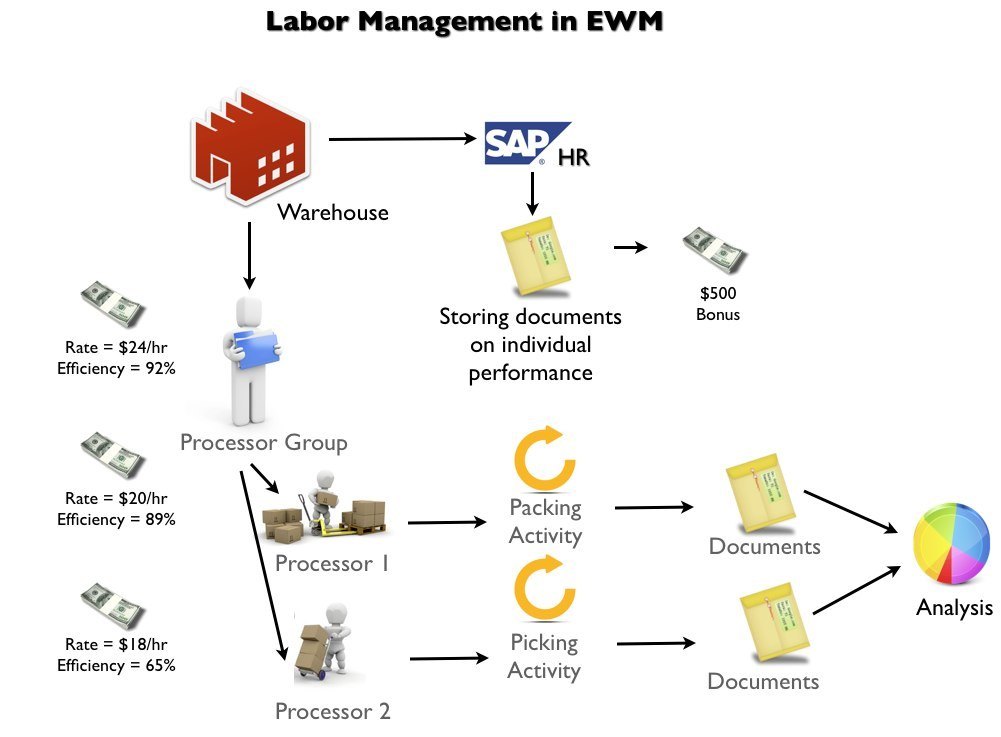How to Best Understand EWM Labor Management
Executive Summary
- Labor is a major cost driver in warehouses.
- Labor Management is a functionality within EWM.
- We cover the major features of Labor Management, comparing actual vs. the plan, integration with HR, and questions to ask if EWM Labor Management is right for you.

Introduction
Labor management was introduced in EWM in SCM 5.1. While labor management is relatively new to EWM, it is quite established with some warehouse vendors. Manhattan Associates, one of the largest WM vendors, has the following to say about labor in the warehouse.
“Labor is a significant cost—typically 55% of the total cost of warehouse operations—yet it is among the most manageable….Labor Management works by storing your database of standards for every key task. For each associate, the actual times for task completion are monitored in real time and compared to standards. Employees at all levels receive immediate feedback on their performance.”
However, people in the warehouse are low paid, so actually, labor should be a higher percentage of the total cost of a warehouse. Yet, with union busting, companies often have their workers on meager wages. Amazon is now famous for using private ambulances as lower in cost than providing air conditioning to warehouse workers.
The Category of Labor Management Software
Labor management is a category of software that is much broader than warehousing. For instance, this demo describes how their software can be used to manage a workforce in a restaurant. This demo is recommended as it provides a quick explanation of the types of things that labor-management offers.

Labor management in EWM is still relatively limited compared to the vendors that specialize in labor management and which offer functionalities such as detailed scheduling and skill matching. The focus of EWM labor management is an enhanced control of employee activities in the warehouse and identifying low productivity time.
Labor Management as a Cost Driver
While new to the topic, labor management is of profound interest to some companies that evaluate EWM.
Major Features of Labor Management
Functions are used to measure, plan, simulate, and visualize the activities in the warehouse.
- Measurement
- Engineering Labor Standards (which can be developed by tracking employees as they progress through tasks.)
- HR Integration (optional)
- Labor Tracking
- Comparison of Actual vs. Plan
- Planning the warehouse workforce
Labor Management Setup
Labor management allows you to define your key figures and map them to measurement services. This can allow you to track:
- Outbound deliveries that have left the warehouse more than 24 hours late
- The number of open physical inventory documents that are older than one day
- The number of handling units in goods receipt.
- Alerts can be based upon the exceptions from the measurement services.
Engineering Labor Standards
They must be set, and a comparison must be made between the performance of the warehouse employees is typically done. This is how long the activity is estimated to take.
A labor factor is applied, which is the rate per worker. Efficiency can be evaluated or the weight that was moved in a particular activity. Planned and executed workloads can be checked, and the labor utilization is the aggregated view of the executed workload. The efficiency value can help accurately determine how many workers are required for the planned tasks in the warehouse.
A planned workload document can be created and used as the basis for planning your resources. This contains information on:
- Activity area
- Activity
- Quantity
- Planned duration
- Planned end date
- Travel distance
- Capacity dat such as weight or volume
Comparing Actual Versus the Plan
After performing the work, it can be used to execute the workload to compare the planning and actual durations. Documents can be sent to the HR system for evaluation and the eventual payment of a performance bonus. Documents can also be queried to check the labor input towards them. This applied for:
- Warehouse orders
- VAS orders
- Quality inspection documents
- Physical inventory documents
- Indirect labor
Labor can be tracked in the following ways:
- Direct Labor (the actual activity)
- Indirect Labor (housekeeping)
- Unproductive Time (Unproductive time)
Direct labor is captured and stored in the EWM documents for warehouse orders, VAS orders, and physical inventory. Indirect labor is recorded by creating indirect labor tasks, and unproductive time is captured by HR.
Integration with HR
Labor management can connect to the HR system. Thus that must be considered if you intend to use it. The incentives can be directly tied to the individual’s HR record. Both individuals and groups can be tracked while activities are assigned to an individual.
Start and end times are necessary for
- Warehouse Order Confirmation
- Physical Inventory Processing and Counting
- VAS Processing Transactions
- Quality Management Related Transactions
- In work center related transactions
Labor management also requires the use of processor master data. A processor is a person who operates a vehicle or other resource. The processor includes skills and is a resource driver or a warehouse employee. The processor is defined as a business partner with the role of the processor. Resources are assigned to warehouses and different processes supported.
Questions to Ask to Determine Whether EWM Labor Management is Right for You
- Are you willing to set up labor standards?
- Are you interested in paying incentive bonuses for work?
- Do you have SAP HR, and if so, are you willing to spend the effort to integrate into it?
- Is labor management a top priority for your project?
- Are you interested in taking advantage of labor-management to plan the labor in your warehouse?
- Are you interested in tracking travel distance?
Labor Management as a Rarely Implemented Functionalty in EWM
At the time of this writing there, I could not find a single technical query on SAP’s developer forum. There were only three questions, and they were all high level and exploratory. However, I did recently consult at a company that has had all of its labor-management integrated with its shop floor system for years (although it does not have a WMS system). The company used and was very happy with their software provider called High Jump.
References
https://www.manh.com/distribution_management/labor_management.html